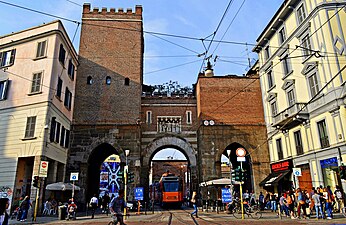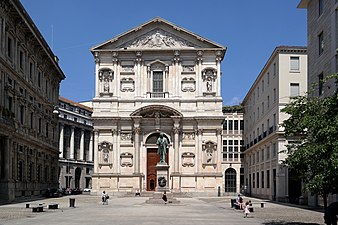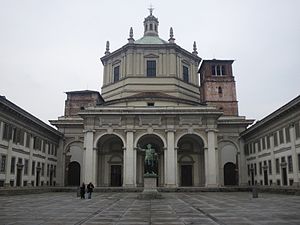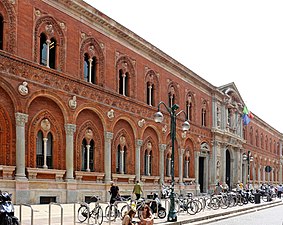
The Castello Sforzesco is a medieval fortification located in Milan, Northern Italy. It was built in the 15th century by Francesco Sforza, Duke of Milan, on the remnants of a 14th-century fortification. Later renovated and enlarged, in the 16th and 17th centuries it was one of the largest citadels in Europe. Extensively rebuilt by Luca Beltrami in 1891–1905, it now houses several of the city's museums and art collections.

Piazza San Babila is a city square in Milan, Italy.
The Nicola Trussardi Foundation is a non-profit institution for the promotion of contemporary art and culture. Created in 1996, the Nicola Trussardi Foundation ran its own exhibiting space in Piazza della Scala in Milan.

Corso Buenos Aires is a major street in north-eastern Milan, Italy. With over 350 shops and outlets, it features the highest concentration of clothing stores in Europe. The architecture of the area is mostly late 19th- and 20th-century style; the street and its surroundings are pointed with several neo-classical and art nouveau buildings.

The Italian city of Milan is recognised internationally as one of the world's most important fashion capitals, along with Paris, New York and London.

The Italian city of Milan is one of the international tourism destinations, appearing among the forty most visited cities in the world, ranking second in Italy after Rome, fifth in Europe and sixteenth in the world. One source has 56% of international visitors to Milan are from Europe, 44% of the city's tourists are Italian, and 56% are from abroad. The most important European Union markets are the United Kingdom (16%), Germany (9%) and France (6%). Most of the visitors who come from the United States to the city go on business matters, while Chinese and Japanese tourists mainly take up the leisure segment.

Via Manzoni is a busy and fashionable street in the Italian city of Milan which leads from the Piazza della Scala north-west towards Piazza Cavour. Notable buildings include the Museo Poldi Pezzoli, the elegant Grand Hotel et de Milan, which was the place of Giuseppe Verdi’s death in 1901, and several fine palaces. Via Manzoni was originally called Corsia del Giardino before the crossroad with Via Monte Napoleone and Corso di Porta Nuova up until Piazza Cavour.

The Quadrilatero della moda, or Via Montenapoleone fashion district, is a shopping district in the centre of the Italian city of Milan. Shops there include both Italian fashion and international brands.

Villas and palaces in Milan are used to indicate public and private buildings in Milan of particular artistic and architectural value. Milan has always been an important centre with regard to the construction of historical villas and palaces, ranging from the Romanesque to the neo-Gothic, from Baroque to Rococo.

Duomo is an interchange station serving Lines 1 and 3 of the Milan Metro.

Porta Sempione is a city gate of Milan, Italy. The name is used both to refer to the gate proper and to the surrounding district (quartiere), a part of the Zone 1 division, including the major avenue of Corso Sempione. The gate is marked by a landmark triumphal arch called Arco della Pace, dating back to the 19th century, although its origins can be traced back to a gate of the Roman walls of Milan.
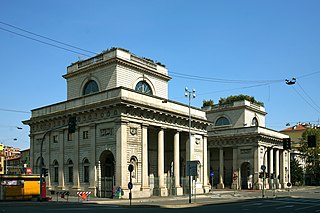
Porta Venezia is one of the historical gates of the city of Milan, Italy. In its present form, the gate dates back to the 19th century; nevertheless, its origins can be traced back to the medieval and even the Roman walls of the city.
The city of Milan, Italy, has had three different systems of defending walls. The oldest, the Roman walls, were developed in two stages: the first in the Republican era and the second in the Imperial era. The second wall system was realized in the Middle Ages, after the destruction of the city by Frederick I Barbarossa. Finally, the latest wall system was built by the Spanish rulers in the 16th century. While very little remains of these walls, their structure is clearly reflected in the urbanistic layout of the city. In particular, modern Milan has two roughly circular rings of streets, namely the "Cerchia dei Navigli" and the "Cerchia dei Bastioni", which essentially correspond to the Medieval and Spanish walls, respectively. Note that a third ring of roads just beyond the Inner Ring Road, called the External Ring Road, does not follow any old city walls, but rather was part of the 1884 Beruto Plan for the city of Milan, created and named after a municipal engineer and public servant to the local city government.
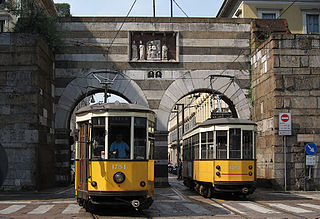
The Milan tramway network is part of the public transport network of Milan, Italy, operated by Azienda Trasporti Milanesi (ATM).
The following is a timeline of the history of the city of Milan, Italy.

Neoclassical architecture in Milan encompasses the main artistic movement from about 1750 to 1850 in this northern Italian city. From the final years of the reign of Maria Theresa of Austria, through the Napoleonic Kingdom of Italy and the European Restoration, Milan was in the forefront of a strong cultural and economic renaissance in which Neoclassicism was the dominant style, creating in Milan some of the most influential works in this style in Italy and across Europe. Notable developments include construction of the Teatro alla Scala, the restyled Royal Palace, and the Brera institutions including the Academy of Fine Arts, the Braidense Library and the Brera Astronomical Observatory. Neoclassicism also led to the development of monumental city gates, new squares and boulevards, as well as public gardens and private mansions. Latterly, two churches, San Tomaso in Terramara and San Carlo al Corso, were completed in Neoclassical style before the period came to an end in the late 1830s.

The following outline is provided as an overview of and topical guide to Milan:

Eugenio Soncini was an Italian architect.















